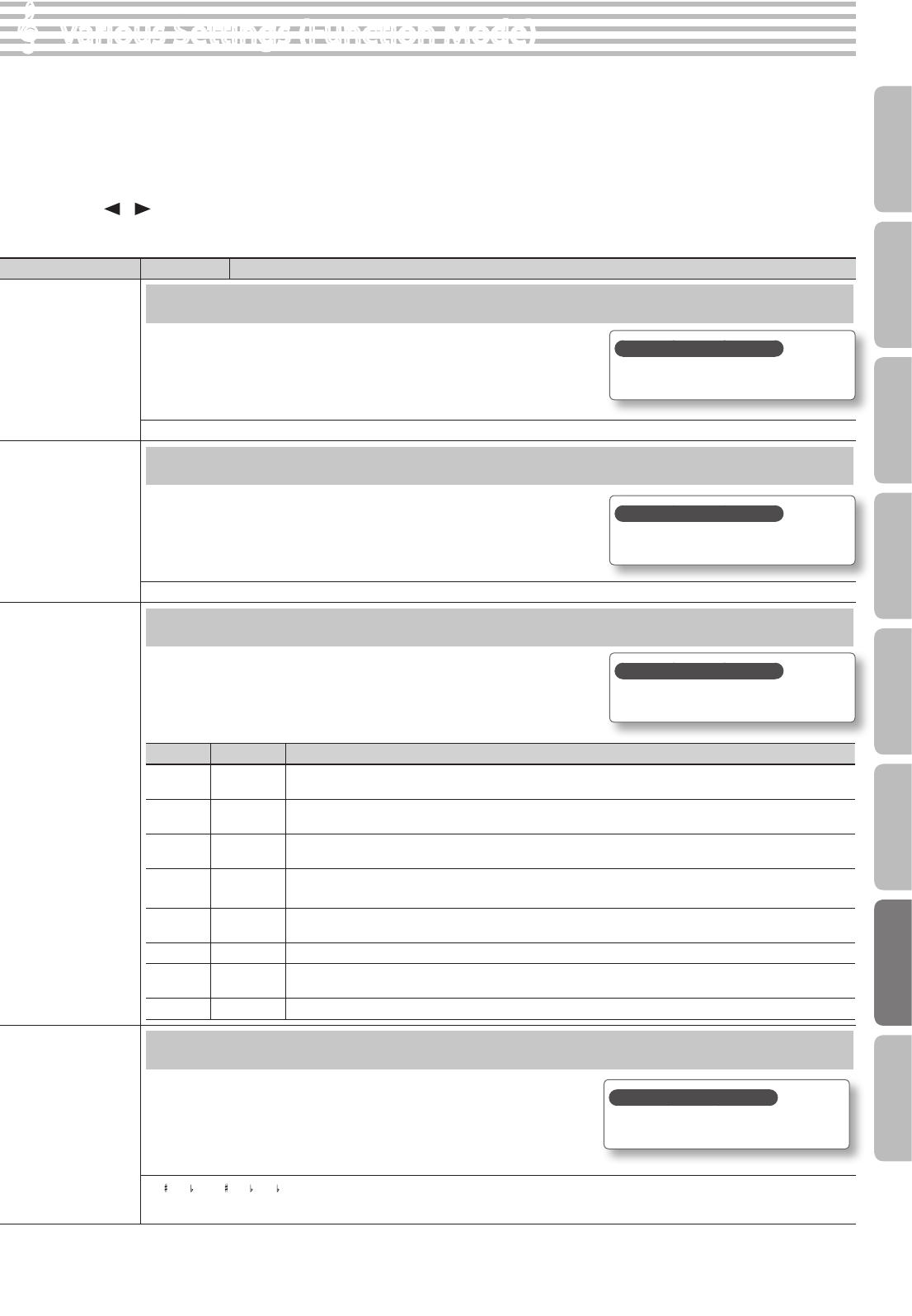
Indication Value Explanation
Dual Bal
Adjusting the Dual Play Volume Balance (Dual Balance)
When using Dual Play, you can adjust the volume balance between tone 1 and tone 2.
9-1 (tone 1 is louder)–9-9 (same volume)–1-9 (tone 2 is louder)
Tuning
Matching the Pitch with Other Instruments (Master Tuning)
When playing ensemble with other instruments and in other such instances, you can match
the standard pitch to another instrument.
The standard pitch generally refers to the pitch of the note that’s played when you nger the
middle A key (A4). For a cleaner ensemble sound while performing with one or more other
instruments, ensure that each instrument’s standard pitch is in tune with that of the other
instruments. This tuning of all the instruments to a standard pitch is called “master tuning.”
415.3 Hz–440.0 Hz–466.2 Hz
Temprmnt
Changing the Tuning Method (Temperament)
You can play classical styles such as Baroque using historic temperaments (tuning methods).
Most modern songs are composed for and played in equal temperament, the most common
tuning in use today. But at one time, there were a wide variety of other tuning systems in
existence. By playing in the temperament that was in use when a composition was created,
you can experience the sonorities of chords originally intended for that song.
Screen Explanation Qualities
EQU Equal
In this tuning, each octave is divided into twelve equal steps. Every interval produces about the same amount of
slight dissonance.
MAJ Just Major
This tuning eliminates ambiguities in the fths and thirds. It is unsuited to playing melodies and cannot be
transposed, but is capable of beautiful sonorities.
MIN Just Minor
The Just tunings dier from major and minor keys. You can get the same eect with the minor scale as with the major
scale.
PYTH Pythagorean
This tuning, devised by the philosopher Pythagoras, eliminates dissonance in fourths and fths.
Dissonance is produced by third-interval chords, but melodies are euphonious.
KIRN Kirnberger
This is an improvement of the Meantone and Just tunings that provides a high degree of freedom of modulation.
Performances are possible in all keys (III).
MEAN Meantone This scale makes some compromises in just intonation, enabling transposition to other keys.
WERC Werckmeister
This temperament combines the Meantone and Pythagorean tunings. Performances are possible in all keys (rst
technique, III).
ARB Arabic This tuning is suitable for the music of Arabia.
Tmpr Key
Specifying a Song’s Tonic (Temperament Key)
When playing with tuning other than equal temperament, you need to specify the
temperament key for tuning the song to be performed (that is, the note that corresponds to
C for a major key or to A for a minor key).
If you choose an equal temperament, there’s no need to select a temperament key.
C, C
, D, E , E, F, F ,G, A , A, B, B
* In the display, a quotation mark (“) signies a sharp (#).
How to save your settings?
Save your settings as described in “Memory
Backup” (p. 41).
How to save your settings?
Save your settings as described in “Memory
Backup” (p. 41).
How to save your settings?
Save your settings as described in “Memory
Backup” (p. 41).
How to save your settings?
Save your settings as described in “Memory
Backup” (p. 41).
Various Settings (Function Mode)
The same procedure is used for all settings in Function mode.
1. While holding down the [Key Touch] button, press the
[Transpose] button.
The [Key Touch] button and [Transpose] button will light; the unit
will be in Function mode.
2. Press the [ ] [ ] (Slow/Fast) buttons to select the
function setting that you want to change.
3. Press the [–] [+] button to edit the value of the setting.
4. Press the [Key Touch] button or the [Transpose] button to
exit Function mode.
45
Operation Guide Panel Descriptions Before You Play Performing Practicing
Convenient Functions
Appendix
Function Mode


















